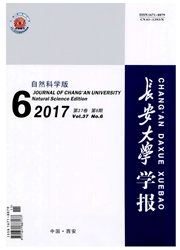

 中文摘要:
中文摘要:
为研究道路景观的最佳设置间距,采用试验方法,设计双车道二级路模拟真实路况环境,按照1~40km设置不同的绿化间隔,随机选择被试驾驶人进行试验,提取景观设置间隔和驾驶人心率作为外界环境的灵敏度衡量指标,量化不同道路景观设置间距下驾驶人的生理、心理反应,发现驾驶人心率和设置间距之间存在指数关系。在对绿化设置间距取对数后,进一步分析,发现驾驶人心率变化率与绿化设置间隔呈U形关系,并使用二次曲线进行拟合并求导。研究结果表明:7km是绿化景观设置的最佳变化间隔,此时驾驶人心率下降最小;该研究揭示了道路环境绿化对驾驶人生理、心理的影响程度,当绿化间距大于或小于7km的时候,驾驶人心率变化率均会增大;计算得出的景观最佳设置间距,可为改善景观环境和提升交通安全水平提供借鉴和参考。
 英文摘要:
英文摘要:
In order to explore the maximum setting distance for landscape, the research was car- ried out in lab which could simulate the second-grade road in real world. Five experiment scenes were designed according to stimulation interval from 1 to 40 kilometers. Each subject was re- quired to drive in a scene randomly at the same time in a day. The stimulation density and heart rate were used to measure road environment. The relationship between heart rate and stimulation density was established. The results show that the degree of fatigue increases during driving time, but the degree increases differently with road environment, which is in consistency with Hancock and Warm U model, and the best interval is 7 km, which means that the heart rate in- creases whenever interval is larger or smaller than 7 km. The best interval from this study can provide reference for road environment improvement and safe driving. 2 tabs, 6 figs, 11 refs.
 同期刊论文项目
同期刊论文项目
 同项目期刊论文
同项目期刊论文
 Assessment of the effects of highway geometric design features on the frequency of truck involved cr
Assessment of the effects of highway geometric design features on the frequency of truck involved cr Examining signalized intersection crash frequency using multivariate zero-inflated Poisson regressio
Examining signalized intersection crash frequency using multivariate zero-inflated Poisson regressio 期刊信息
期刊信息
